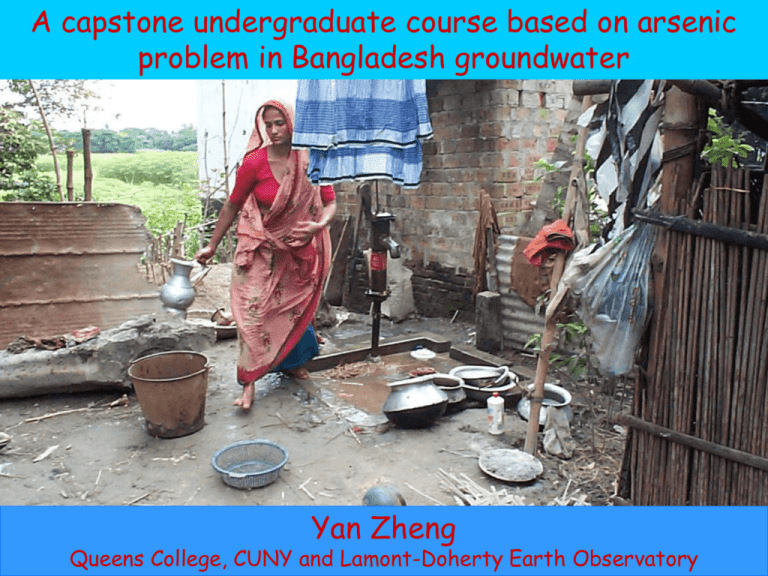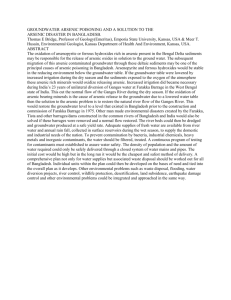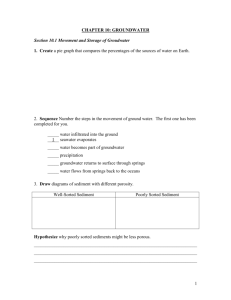A capstone undergraduate course based on arsenic
advertisement

A capstone undergraduate course based on arsenic problem in Bangladesh groundwater Yan Zheng Queens College, CUNY and Lamont-Doherty Earth Observatory “Environmental Problem Solving” Environ. Sci. & Studies Senior A simulation of actual environmental problems and case histories that utilize interactive, self-directed investigations by student teams. Oral and written presentations in mock environmental hearings are required. Why Arsenic in Bangladesh Groundwater About 40 million people exposed to > 50 mg/L As (US drinking water MCL 10 mg/L) Chronic exposure leads to various cancers, skin and cardiovascular diseases. Multidisciplinary: Earth Science, Health Science, Engineering, Social Science http://superfund.ciesin.columbia.edu •About 10 million tube wells supply 97% population’s drinking water • 50% wells > 10 mg/L As • 28% wells > 50 mg/L As UNICEF & DPHE 50,000 well test groundwater 25% volume As in groundwater 7950 mg/l Solid 75% volume Dissolve Desorb Mobilizable As in sediment 1 mg/kg Proximate Source of As: Reducing Condition (Anoxic with dissolved Fe) Ultimate Source Hypothesis: Physically weathered but not-chemically weathered Fe-Mg minerals in rapidly accumulating sediment (Holocene delta/fluvial plain, glacial till) Fluvial Flood Plain Delta Plain Zheng et al., submitted http://www.bgs.ac.uk/arsenic/ Age distribution of tube wells in Araihazar and in Bangladesh Number of wells doubled in past 5 years (van Geen et al., 2002) As distribution in 6000 tube wells from Araihazar (van Geen et al., WRR, 2002) C E A B G F Groundwater As(III) and As (Zheng et al., submitted & in prep) A 0 400 600 200 400 0 600 0 20 20 20 Depth (m) 40 60 0 0 200 200 400 60 400 600 60 200 B 400 600 100 0 0 20 40 600 40 F 100 0 600 0 400 80 G Depth (m) 60 60 80 20 40 40 200 20 Depth (m) 100 Depth (m) 0 Pleistocene 80 Depth (m) 0 0 Holocene Depth (m) 200 E C 40 60 80 80 80 100 100 100 Holocene Deep Aquifer Sustainability Withdrawal rate: Drinking (10L/person day) 1 cm/yr Irrigation 60 cm/yr A (Dari) B (Bay) Residence Time (kyr) 10 1 Recharge Rate (cm/yr) 0.15 1.5 Clay thickness (m) 15 1 Hydraulic Cond. (cm/s) 5x10-8 5x10-7 Vertical hydraul. Grad (m) 1 0.1 Leakage Rate (cm/yr) 1.6 0.2 Conductivity HCO3 Dominant cation pH Shallow Hol. H H Ca, Mg 6-7 Deep Pleist. (A) L L Na 6 Deep Hol. (B) L H Na 7-7.5 14C-DIC Tritium Sediment As Bomb Bomb H Deep Pleist. (A) 0.3 N.D. L Deep Hol. (B) 0.8 (N.D.) L Shallow Hol. P-ext As mg/kg 1-2 0.1-0.2 As ORP Fe Mn SO4 NH4 PO4 Shallow Hol. H - H H H H H Deep Pleist. (A) <5 + L L L L L <10 - L L L L L Deep Hol. (B) Conclusions (Zheng et al., submitted to WRR) groundwater As concentrations can be low in deep aquifers with a very different depositional history and a very different residence time relative to recharge. The concentration of easily mobilizable As present in the sediment is a key explanatory variable for dissolved As in groundwater. Usage of the deep aquifers for domestic water consumption appears to be sustainable. the deep aquifers should not be used for irrigation until the hydrological and chemical responses to increased withdrawals are better understood. Targeting Safe Aquifer: Test and Map Existing Wells Site A S##S #S #S #S #S #S #S #S #S #S#S#S#S #S#S S##S #S S# S##S #S #S S# S##S#S#S #S #S #S#S #S #S#S #S#S #S#S #S #S #S #S #S #S #S #S S # #S #S #S #S#S #S #S #S #S #S%U S# #S #SS# #S S# S# #S #S S##S#S #S#S #S#S#S#S #S #S#S%U #S#S%U #S#S#S#S#S S# #S #S#S #S #S #S %U#S%U%U#S#S #S#S#S%U#S #S #S#S%U #S #S S# #S #S #S%U #S #S #S S# #S #S #S U# % #S#S #S S# #S S # S#S%U#S%U #S #S S # S # S # S # S # #S # S S # #S #S%U #S #S #S #S#S #S #S #S#S #S%U #S #S #S #S #S#S #S #S#S#S S#S# #S #S #S #S#S #S #S #S#S #S #S #S #S#S#S #S#S#S#S #S#S%U #S #S #S #S#S #S #S #S #S #S S# #S S##S #S #S S# S# #S #S#S #S S# #S S# S# #S#S#S #S S# #S#S#S As (mg/l) <5-820 #S S##S #S 30-55ft 132+-144 mg/L As #S #S #S #S #S #S 0 S# #S#S#S 0.2 S##S#S 0.4 0.6 0.8 1 Kilometers Longitude (degree) Depth ft 90.596 0 90.598 90.6 90.602 90.604 90.606 90.608 90.61 50 14C 100 150 200 5--10" 10--50 50--100 100--400 400-800 dead Text: Student Activities BGS Phase II Report 1-hr lecture & 2-hrs data manipulation Grade: Team Presentation and Report (5-page) (1x20%) Peer Review (1-page) (2x20%) Proposal Presentation (10%) Proposal (15-page; 30%) Syllabus Science Background: Geology, Hydrology & Geochemistry Science Investigation: Team 1: three special study area Team 2: A village survey and spatial scale of variation time scale of variation Mineralogy and sediment chemistry mechanism of As release – summary Engineering: Remediation Measures Geological engineering: deep well, dug well, well-switching Water engineering: Arsenic removal techniques Policy Introduction to policy issues (Strategic Plan) Team 3: Social and economical issues in remediation policy Data Manipulation: Excel As (ug/L) 0 0 50 100 Depth (m) 150 200 250 300 350 400 500 1000 1500 2000 Data Manipulation: ArcView Map of As distribution in groundwater Proposal Guideline Propose a solution for a specific aspect of the arsenic problem in Bangladesh groundwater A.executive summary B.statement of the problem C. objective D.hypothesis E.approach F. expected results and significance Summary of Student Proposals Well sharing as short-term solution Deep well and pond sand filter on a community level Removing arsenic from groundwater: treatments vs. deep tube wells The principle of arsenic removal from groundwater by iron impregnated sand Alternative source of drinking water: rain water harvesting Rain water harvesting using a large polyethylene storage container Solving arsenic problem using educational and economical approach Evaluation of safe water options and recommendation Possible treatment of arsenic related affliction Examples of Hypothesis Through a number of different methods, year-round supplies of arsenic-safe drinking water can be made available to the people of Bangladesh at relatively low cost. Until the effects of metabolic methylation of AsV and AsIII are completely understood, no treatment advocating the acceleration or aiding of this process should be recommended as a primary mode of treatment. By educating the people of Bangladesh through BRAC schools, the people of Bangladesh would come to the realization of the poison in their water and hence not use the contaminated water as their drinking water. My other hypothesis is that if the American public were aware of the catastrophe in Bangladesh, the people of America would sympathize and make monetary contributions. This in turn would help out with some of the cost of treating the arsenic in Bangladesh. What works: anecdotal evidence Data manipulation enhances learning Peer review keeps the student engaged Oral presentation before submission of written reports or proposal Student Evaluation (n=10) Communication 4.4 Assignments, Grading 4.3 Faculty Interaction 4.3 Outcomes 3.9 1: strongly disagree; 5: strongly agree Q: The instructor clearly presented course requirements and objectives early in semester Learned a great deal but only enjoyed the course moderately Moderately difficult, taught at just about right speed, with moderate to somewhat heavy workload 6 5 5 Enjoyed the course Learned a great deal 6 4 3 2 4 3 2 1 1 0 0 0 1 2 Current GPA 3 4 0 1 2 Current GPA 3 4 Acknowledgement Collaborators Columbia: A. van Geen, M. Stute, M. Steckler, R. Versteeg, J. Simpson, Z. Cheng SUNY Stony Brook: S. Goodbred Israeli Geol. Survey: I. Gavrieli Dhaka: K. M. Ahmed Students CUNY: R. Dhar, Y. He, Z. Mo Columbia: A. Horneman SUNY Stony Brook: B. Weinman Dhaka: M. Shanewaz, M. Shams, A. Sedique, M. Hoque Funding Agency NIEHS/Super Fund Basic Research Program NSF EAR & INT Columbia Earth Institute Geology and Human Health Workshop Conveners What is Environmental Science? What is the core knowledge expected of an environmental science major? Does it make sense to have biology, chemistry and geology tracks? Should geologists take an active role in defining the core knowledge of environmental science? A textbook for introduction to the environment Resources (energy, air, water, food) Human impact on the environment Human impact on human health Case studies of environmental issues of global impact Laboratory modules based on local environmental issues a bit of background about your issue (e.g. As in groundwater in Bangladesh), and then how you use this topic or issue in your own instructional activities. What do the students have to know about the subject? What activities do you have them do? Do they do projects? Modeling? Access databases and tools and plot results? etc. Most of the participants will want to know "what works" based on your experience in teaching about this, and also what barriers or problems you might expect to encounter (i.e. teaching tips about how to design and implement your type of project). Again, after doing many workshops of this type, it's our experience that folks will not want to use your materials/approaches directly, but they will want to develop similar activities for their own students, in their own instructional setting, in their own courses, etc. So, any advice you can give folks to take home about how to design, implement and assess student activities would be a really nice contribution hyperpigmentation keratosis skin cancer fatalities due to internal cancers neurological problems miscarriages premature delivery in reproductive females Hypothesis: Floodplain evolution can explain the distribution of arsenic in Araihazar Weinman et al., in prep










